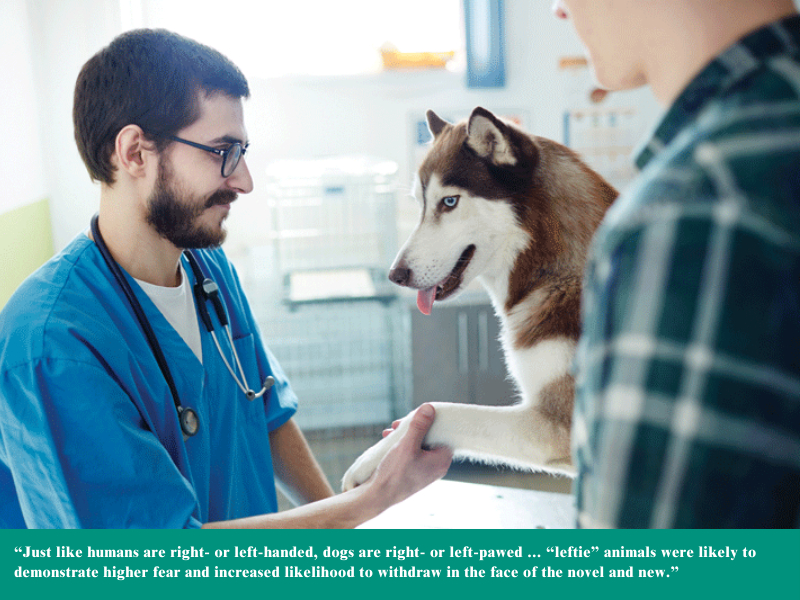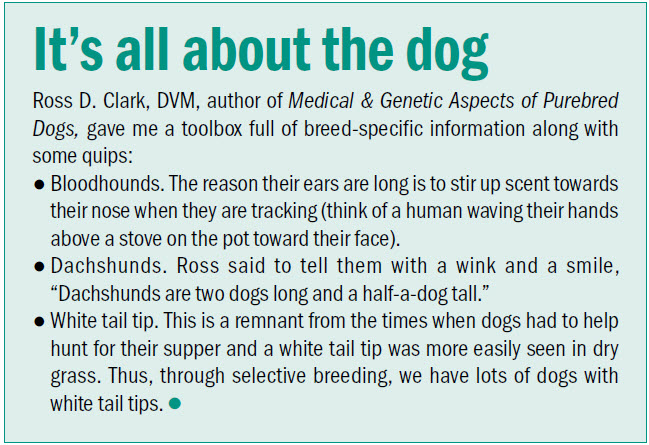
I learned from my first and longest mentor, Ross D. Clark, DVM, to bring a little theater to the exam room. Sure, we must have the science or the “steak” in the practice, but we can also bring the soul or the “sizzle.”
Here are five fun facts you may not know that you can share with clients, team members, or in your marketing efforts:
1) Greeting pets. The vast majority of people greet pets incorrectly. Most people do this when greeting a dog: a) walk up to the dog, b) have prolonged, direct eye contact, c) loom over the pet, d) stick their hand or fist in the pet’s face.
Here is how you should greet a dog: a) let the dog come to you, b) glance at dog but avoid prolonged eye contact c) turn sideways, or better yet, take a knee to reduce your size, and d) pat the side of your leg and call the dog over to you.
2) Dogs have a right or left paw preference. Just like humans are right- or left-handed, dogs are right- or left-pawed. The right side of the brain controls more negative emotions, such as fear, aggression, and taking flight in response to a perceived threat, whereas the left side of the brain is associated with more positive emotions that include feelings of love, safety, attachment, and comfort. This may relate to paw preference in that for people with right hand preference, the left side of their brain controls their dominant hand, which also may influence an increased likelihood for being in a positive emotional state. Or, oppositely, with the right brain dominant in the leftie, this also increases the likelihood of right brain emotions taking precedence; meaning, a more negative state of mind is likely.
Another study1 with guide dogs shows the decreased likelihood of “lefties,” or dogs with left paw preference, passing the guide dog program, with only 38 percent passing the training. In comparison, 64-68 percent of righties and ambidextrous dogs passed the guide dog program.
Such findings may correlate with other research2 showing “leftie” animals were likely to demonstrate higher fear and increased likelihood to withdraw in the face of the novel and new.
3) “Telltail” signs. Research shows the direction a dog primarily wags his tail in, either to the left or the right, can actually speak to how the dog feels about the individual they are facing.3 If to the left, this signals greater likelihood of fear, anxiety, uncertainty, and concern, and indicates the dog may want to move away. If primarily wagging to the right, it indicates expectation of a more feel-good, happy, relaxed encounter the dog wants to be a part of.
Even more amazing is how watching the tail wag direction moving more to the right or the left was a difference that was noticed by other dogs that responded with increased anxiety and heightened heart rate to dogs with tails wagging more to the left and remained or relaxed, or even attempted to approach, when another dog’s tail wagged more to the right.
4) Know noses. Humans mostly use our eyes to take in the world. Dogs rely on their noses; their sense of smell exceeds ours by a factor of between 10,000 and 100,000. Research also suggests they sniff five to 10 times per second, while we sniff about once.4
However, for the other two smells (the veterinarian’s sweat and adrenaline), that perhaps may not be quite as welcome to a dog, the dogs always smelled them with their right nostril. Even though the smell of the vet would be as familiar to the dogs as perhaps dog food or the smell from a female dog, it could be more stressful to the dogs (as any dog owner knows, taking it to the vet generally is not a relaxing event for anyone involved). The fight-or-flight response is mainly dealt with by the right side of the brain. Therefore, even though these smells became as familiar as the other ones did, they elicited enough strong emotions, such as fear, to continue being processed by the right-side of the brain (and, therefore, the right nostril).
5) Are those bumps on a dog’s lower lip? The bumps or ridges on a dog’s lips are known as ruga, rugal folds, or lip fimbrai. These bumps, which look like a serrated knife but with rounded nubbins instead of sharp edges, are a normal part of the dog’s anatomy and serve an essential function in helping them grip and manipulate their food.
Most dogs have around 15 of these on each side. The serrations protect the dog’s gums from the sharp canine teeth. The upper and lower canine teeth rest on the serrated lip protecting the gums. They may also act as sensors keeping the lip out of the teeth’s way, preventing the dog from biting their own lip.
The rugal folds on a dog’s lip act as a conveyor belt, moving food toward the back of the mouth and helping dogs maintain a secure grip on the food as they chew (like crampons). These folds, which some liken to a series of rounded hills, also help create suction, allowing dogs to drink more efficiently as they ladle water into their mouths with a backward curved tongue. Further, rugal folds keep teeth clean. Frederic Wood Jones, a professor of anatomy, stated the reason for the serrated bumps, along with other elements of a dog’s mouth, was all evolution’s work in keeping the dog’s teeth clean.5 People who agree with this theory have pointed out this may make sense, as today’s toys claiming to clean dog’s teeth usually have ridges, spikes, bumps, etc., similar to the way those serrated bumps may do so inside of a dog’s mouth.
The great communicators of history, from Jesus Christ and Mohammed, to John F. Kennedy and Barak Obama, know the best way to memorably communicate is through storytelling. When I engage in stories, I do not think of it as selling so much as searing into the pet parent’s mind tidbits about their beloved pet that will deepen the human-animal bond experience.
Marty Becker, DVM, writes regularly for Veterinary Practice News. Dr. Becker is a Sandpoint, Idaho practitioner, and founder of the Fear Free initiative. For more information about the organization or to register for certification, visit http://feafreepets.com/. Columnists’ opinions do not necessarily reflect those of Veterinary Practice News.
References
- Goldblatt, A., Gazit, I., Cappon, E., & Terkel, J. (2023). Paw Preference as an indicator of operational suitability in working dogs: An ex post facto analysis. Applied Animal Behaviour Science, 262, 105900. https://doi.org/10.1016/j.applanim.2023.105900
- Simon, T., Frasnelli, E., Guo, K., Barber, A., Wilkinson, A., & Mills, D. S. (2022, April 29). Is there an association between Paw Preference and Emotionality in Pet Dogs?. Animals : an open access journal from MDPI. https://www.ncbi.nlm.nih.gov/pmc/articles/PMC9103732/
- Ren, W., Wei, P., Yu, S., & Zhang, Y. Q. (2022, July 9). Left-right asymmetry and attractor-like dynamics of dog’s tail wagging during dog-human interactions. iScience. https://www.ncbi.nlm.nih.gov/pmc/articles/PMC9356099/
- Hoffman, J. (2016, October 10). Learning from dogs as they sniff out their world. The New York Times. https://www.nytimes.com/2016/10/11/science/dogs-can-train-us-to-have-a-better-sense-of-smell.html
- Jones FW. The Sublingua and the Plica Fimbriata. J Anat. 1918 Jul;52(Pt 4):34 5-53. PMID: 17103846; PMCID: PMC1262842.

